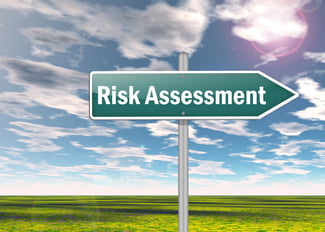Posted by James Legatt ● October 10, 2019
Applying Lessons Learned to Risk Assessment in Learning Projects
 Risk assessment can be a time-consuming task when starting a project—it is valuable project time that many project managers would prefer to allot elsewhere. However, performing effective risk assessment at the start of a project can save valuable time during the project and create opportunities for overall process improvement. There are ways of fast tracking discovery, but mitigation strategies should always be customized to the project and include consideration of solutions, budgets, schedules, and most importantly, project resources. Risk assessment is appropriate whether the project is with external clients or internal stakeholders.
Risk assessment can be a time-consuming task when starting a project—it is valuable project time that many project managers would prefer to allot elsewhere. However, performing effective risk assessment at the start of a project can save valuable time during the project and create opportunities for overall process improvement. There are ways of fast tracking discovery, but mitigation strategies should always be customized to the project and include consideration of solutions, budgets, schedules, and most importantly, project resources. Risk assessment is appropriate whether the project is with external clients or internal stakeholders.
Risk assessment is not insurance against issues arising on projects. Rather, it is an awareness that issues may arise, and an opportunity to create appropriate responses to those potential issues. As project managers and supporting team members, we should seek to discover all risks—positive, neutral, or negative—before starting projects. In fact, risk identification before developing a kick-off presentation allows for an early opportunity to gather full team insight. Risk assessment is not pessimistic; rather, raising concerns is one of the most reliable traits of a project manager.
Using Lessons Learned
There is no single correct process in assessing risk—it can be done informally or formally, in a very structured approach, or even in unplanned conversations. Each approach has its pros and cons. Informal risk assessment can be performed via brainstorming. This tactic works well for simple projects with overall low risk. Formal risk assessment often is conducted in a structured environment and works well when the participants buy in to the process being applied.
One approach for risk assessment is to use project lessons learned to populate your risk register or guide brainstorming for future projects. Two common project risk categories are schedule and quality, and these are good starting points for any risk discussion. Even specific lessons learned on one project can be generalized for any other project in its early stages.
There’s a strategic side to using lessons learned as risk management—it shows the organization continuous and steady improvement in the overall project management methodology. Improvements can be celebrated as wins during reviews and can exhibit commitment to producing a quality product and engagement. Using the topic of continuous improvement as a conversation starter also allows for deeper conversation about challenges facing the organization and opportunities to consult with stakeholders and for the PMO (Project Management Organization) to build trust and credibility. The willingness to discuss challenges shows maturity and professionalism.
Below, we take lessons learned from project close-out discussions to explore future risk. Risk mitigation is not strictly on the project manager. It’s a responsibility for all stakeholders and project team members. The following risk aversion strategies explain and show what is needed in the early phases of a project. By doing so, it encourages collaboration and two-way communication.
Assessing and Mitigating Timeline Risk
 Stakeholder reviews that extend beyond the allotted schedule are not uncommon. Prolonged review cycles can cause loss of momentum and focus for the entire team. Extended review cycles frequently lead to changes to the project schedule and recalibrations to design and resourcing. Often, stakeholders are not prepared to work with the project team, and are not informed when their role as reviewer starts. Below, we’ve identified a few ways to mitigate risk of overdue review cycles.
Stakeholder reviews that extend beyond the allotted schedule are not uncommon. Prolonged review cycles can cause loss of momentum and focus for the entire team. Extended review cycles frequently lead to changes to the project schedule and recalibrations to design and resourcing. Often, stakeholders are not prepared to work with the project team, and are not informed when their role as reviewer starts. Below, we’ve identified a few ways to mitigate risk of overdue review cycles.
- Arrange a detailed project kickoff, where you and project stakeholders will:
- Identify reviewers
- Empower reviewers by clarifying roles and responsibilities
- Evaluate review timelines together to ensure timelines can be committed to by all
- Define reviewer roles with in-depth descriptions and defining feedback that is actionable, aligned, and consolidated
- Ensure reviewers understand responsibilities and tools: Rather than handing off the reviews with a request for feedback in the allotted time in a format unfamiliar to the stakeholder reviewer, take the time to revisit what was discussed during the project kick-off and walk through the chosen QA tool.
- Schedule as needed in-depth schedule discussions: There is often a milestone discussion during project kick-off. But as more is known about the project, an in-depth schedule discussion should take place along with discussing what will happen during each phase and who needs to be engaged. It is good to include a reviewer discussion to ensure unexpected people won’t be entering the review cycle late in the project. All of these are opportunities to act in the best interests of the project and the organizations we support.
Assessing and Mitigating Quality Risk
Quality isn’t added in but is built in to every step of the process. Recently, during a lessons learned session, a stakeholder expressed uncertainty around what was needed and when it was needed. When project managers are ambiguous about what inputs are needed and when, it is extremely difficult for stakeholders to provide input. When a stakeholder's role is uncertain, the quality of feedback, source materials, and even communication will suffer.
Use the project kickoff to prompt critical conversations while you have most, if not all, of the project team together. Be sure to discuss the following items in detail so the right people are engaged at the right time with the right information.
- Who is the [role]? For instance, if there are multiple reviewers, is one of them the consolidator and approver? Consider introducing and/or discussing key roles project teams may have never used or considered, such as:
- Lead Decision Maker vs. SME
- SME vs. Stakeholder
- Technical SME vs. Learner SME
- Why is the [role] needed on the project? This discussion fills in the purpose of the role and why it’s important to project success. This is a great opportunity on large SME group projects or extensive deliverable projects to first confirm SME engagement needs and responsibilities. Then determine whether it makes more sense to divide and conquer work, versus having every SME on every deliverable.
- What is needed from the [role] on the project? This helps to prepare the resource for what is needed from the role, enabling them to fill in details on the storyboard, alpha review, change validation during beta, or sending project acceptance.
- When do we need to engage the [role]? Looking ahead to the schedule discussion, going through the various phases of the project will allow for SME or reviewer scheduling for all phases of the project. It is highly recommended to schedule events in advance when possible—consider adding recurring meetings for phases of a project when SME touchbacks could add value, such as during storyboard phase. It’s always easier to cancel time with SMEs than trying to schedule time at the last minute.
Continue with reinforcement during all phases where specific actions are needed from the stakeholder. For example, a complete walk-through with reviewers on how to use the Articulate 360 QA tool is time well spent. In addition to sending review instructions with every deliverable, a walk-through prior to each review stage will instill confidence and reduce questions and uncertainty. Consistency and predictability assure reviewers that they will be supported throughout the project.
Risk assessment is a skill set all project managers should seek to better develop. It enables project managers to effectively evaluate the potential risks lurking within a project and unlocks opportunities for project wins that might otherwise not be visible.
Topics: Instructional Design

